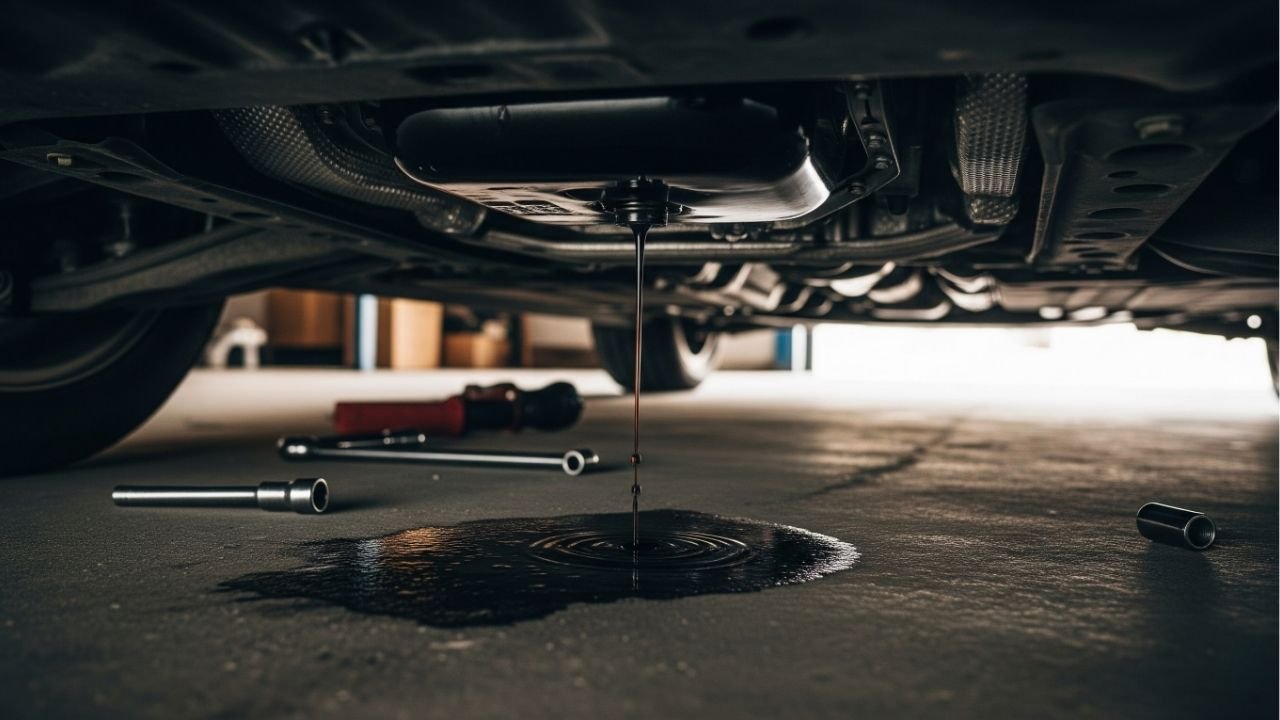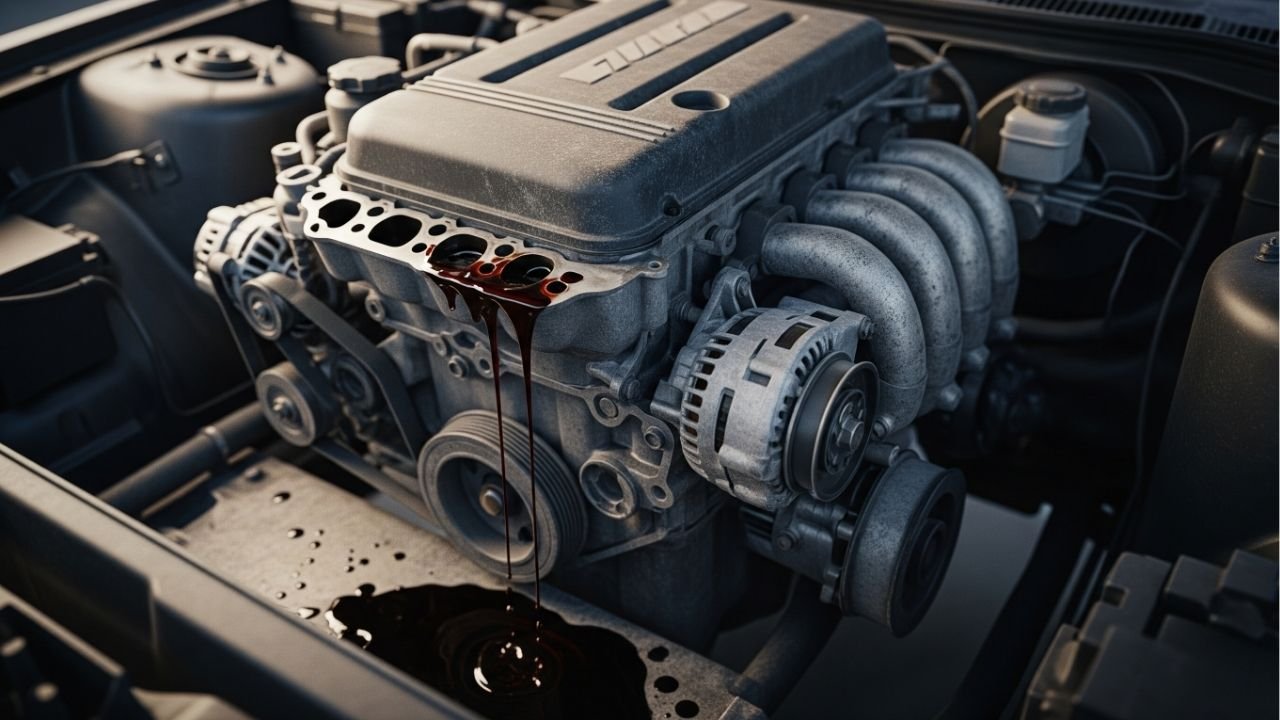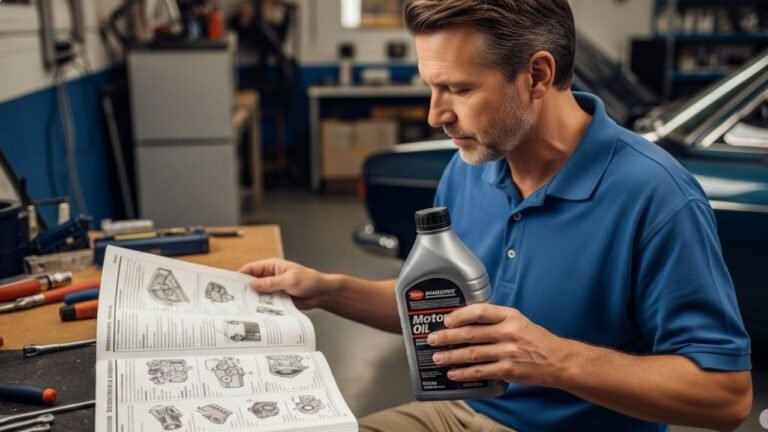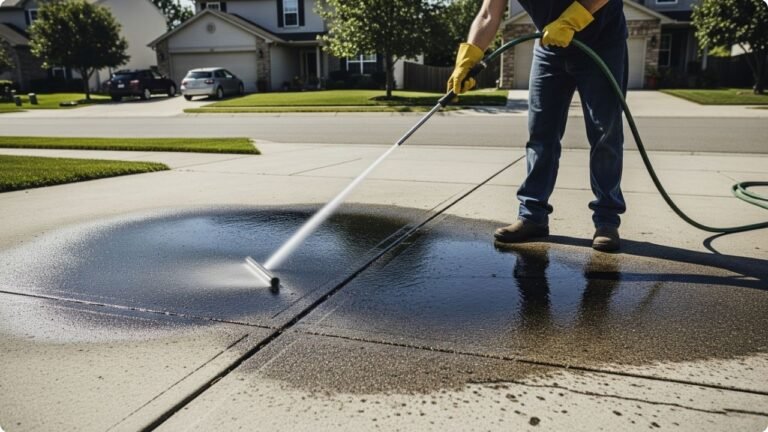Where Can My Car Be Leaking Oil From?

Ever walked out to your car in the morning, only to find a dark, greasy puddle staring back at you from under the engine? Yeah, I’ve been there too. It’s like your car is crying, but instead of tears, it’s leaking oil—and it’s trying to tell you something important.
Now, here’s the million-dollar question we all end up asking sooner or later: “Where can my car be leaking oil from?” It’s a worry that creeps up on new drivers and seasoned car lovers alike. Whether you drive a brand-new hybrid or a 15-year-old truck, oil leaks don’t discriminate. They’re sneaky, messy, and potentially expensive if left unchecked.
In this guide, I’ll break it down for you—every common place your car could be leaking oil from, what signs to look for, how serious it could be, and when to panic (and when not to). We’ll keep things light, friendly, and clear because car talk doesn’t have to sound like a mechanic’s textbook.
What Causes Oil Leaks in the First Place?

Here are the most common reasons your car may start leaking oil:
-
Worn or damaged gaskets and seals
-
Loose or stripped oil drain plugs
-
Overfilled or incorrectly installed oil filters
-
Cracked oil pans or valve covers
-
High engine temperatures warping components
-
Normal aging and wear of engine components
Each of these reasons ties back to a different leak location, which we’ll now explore in detail.
1. Oil Pan Gasket – The Unsung Hero Below Your Engine
One of the most common oil leak sources is the oil pan gasket. Think of it like the kitchen seal under your sink—if it wears out, things start dripping fast.
The oil pan sits at the very bottom of your engine, holding the motor oil when your car is off. A rubber or cork gasket seals the pan to the engine block. Over time, vibrations and heat cycles wear down the gasket, and oil starts to escape.
Signs it’s leaking:
-
Oil puddles near the front or center of your car.
-
A noticeable drop in oil levels without visible smoke or noise.
-
Greasy residue on the bottom of your engine or oil pan.
Personal Tip:
I once ignored this leak on my Honda for months, thinking it was just a “sweat.” Turns out, I lost over a quart a week, and it nearly wrecked my engine. Lesson: never ignore a low oil warning if your driveway looks like a crime scene.
2. Valve Cover Gasket – Leaks From the Top Down
Let’s move up—way up—to the valve cover gasket. This sits at the top of your engine, sealing the cylinder head and protecting the rocker arms. Since it’s exposed to heat, pressure, and time, it’s also a frequent oil leak point.
When this gasket starts to fail, oil doesn’t always hit the ground right away. Instead, it can drip down the sides of your engine and burn off before you see a puddle.
Watch for:
-
A burning oil smell, especially after driving.
-
Smoke coming from under the hood.
-
Oil residue on spark plugs (this can cause misfires!).
-
Slight oil seepage on the upper engine area.
Extra Insight:
This leak can trick you because it’s not always obvious. One friend of mine thought he had an exhaust problem—turns out, it was hot oil cooking off the manifold. So if you smell oil but don’t see a leak, check the top.
3. Oil Filter or Oil Plug – Small Parts, Big Leaks
These two get overlooked, but they’re simple and high-leak-risk spots.
-
The oil filter can leak if it’s over-tightened, under-tightened, or has a bad gasket.
-
The oil drain plug (at the base of the oil pan) can leak if it’s cross-threaded or not tightened properly after an oil change.
Symptoms:
-
Oil dripping right after an oil change.
-
Puddle directly under the drain plug area.
-
High oil usage without driving many miles.
What To Do:
If you’ve just had your oil changed and suddenly notice oil on the ground, double-check these two parts first. They’re quick to inspect and might save you a trip to the shop.
4. Front and Rear Main Seals – The Invisible Leaks
These seals are the hidden gatekeepers where the crankshaft exits the engine. The front main seal is behind the timing cover, while the rear main seal sits between the engine and transmission.
They’re not visible unless you take the engine apart, and they can cause slow leaks that worsen over time.
Clues you’re dealing with one of these:
-
Oil leaking from the middle or rear of the engine.
-
Clutch slipping (in manual cars) if oil gets on it.
-
Steady, slow oil loss over time.
A Word of Caution:
These leaks often require major labor to repair. They’re not urgent if the leak is minor, but you should monitor oil levels closely.
5. Timing Cover Gasket – An Overlooked Culprit
The timing cover protects the timing belt or chain and contains oil to lubricate those moving parts. Its gasket is subject to constant pressure and temperature shifts.
When it fails, you might see oil dripping near the front of the engine, sometimes even mixing with coolant.
Red Flags:
-
Oil and coolant mixing (milky oil on the dipstick).
-
Dripping oil from the front of the engine block.
-
Unusual noises from the timing chain area.
This kind of leak often comes with other symptoms like overheating or loss of power, so don’t sleep on it.
6. Camshaft and Crankshaft Seals – Small Circles, Big Damage
Both your camshaft and crankshaft pass through engine walls, and they need seals to hold the oil in. These rubber rings degrade over time and let oil seep out under pressure.
Indicators:
-
Oil stains around the timing belt housing.
-
Belt slippage or squealing sounds.
-
Constant low oil warning despite topping up.
You may not notice these until they’ve already made a mess. If your mechanic mentions them during service, believe them—these small leaks can quickly grow.
7. Oil Cooler Lines or Hoses – Pressurized Paths to Leakage
Some cars have oil coolers to regulate engine temperature. These systems rely on hoses that carry oil under pressure. If the hoses crack, wear, or the clamps loosen, they’ll leak fast.
What You’ll See:
-
Oil trails behind the vehicle (if leaking while driving).
-
A fast loss of oil even if you recently topped it off.
-
Smell of burning oil on long drives.
These leaks are often misdiagnosed because they can spray oil onto other parts. Look for wet hoses or fittings.
Quick Summary Table – Common Oil Leak Sources
| Leak Location | Main Clue | Severity |
|---|---|---|
| Oil Pan Gasket | Puddle under engine | Medium |
| Valve Cover Gasket | Burning smell, oily engine top | Medium |
| Oil Filter / Plug | Leak after oil change | Low to Medium |
| Rear/Front Main Seals | Steady leak near transmission | High |
| Timing Cover Gasket | Coolant and oil mixing | High |
| Cam/Crankshaft Seals | Stains near timing belt | Medium |
| Oil Cooler Hoses | Fast leaks, oil smell on highway drives | High |
How to Diagnose an Oil Leak – The Easy Way
You don’t need to be a mechanic to figure out where your car is leaking oil from. All it takes is a little observation, patience, and maybe a flashlight.
Here’s a simple step-by-step method you can try at home:
-
Check the Oil Level
-
Pull out the dipstick and wipe it clean.
-
Reinsert it fully and pull it out again.
-
If the oil level is low or dropping, you’ve got a leak or it’s burning oil.
-
-
Look for Drips or Puddles
-
Place cardboard or newspaper under your car overnight.
-
In the morning, check the location and shape of the stain.
-
Front of the car? Likely oil pan or filter. Rear? Rear main seal or cooler lines.
-
-
Inspect With a Flashlight
-
Look around the oil pan, valve cover, and oil filter.
-
Wet, shiny, or sticky areas often point to the leak.
-
Trace the oil upwards—gravity pulls oil down, but it leaks from the top.
-
-
Smell for Burning Oil
-
Burning oil smells sharp and bitter.
-
If you smell it in the cabin, it might be dripping on your exhaust manifold.
-
-
Use UV Dye (Optional)
-
Available at auto parts stores.
-
Add to oil, run the car, then inspect with a UV flashlight.
-
Glowing oil makes leaks easier to trace.
-
Real talk: I used this method on my old Toyota Corolla, and it showed the leak was coming from a valve cover bolt that was just slightly loose. A simple half-turn with a socket wrench fixed it.
Can You Drive With an Oil Leak?
This question is tricky because the answer is: sometimes yes, sometimes absolutely not.
When it’s (maybe) okay:
-
The oil leak is small, and you’re topping off regularly.
-
It’s not leaking onto hot components (like the exhaust).
-
No warning lights are on, and the engine sounds normal.
When it’s not okay:
-
Oil is leaking quickly—you’re losing a quart in days.
-
The engine smells like burning oil or smokes.
-
The oil pressure light turns on.
-
You hear knocking, tapping, or ticking noises.
-
You see milky oil, meaning coolant may be mixing with oil.
Bottom line? If you’re asking “Where can my car be leaking oil from?”, it’s best to check how much oil is leaking. Driving with too little oil is like running a marathon in flip-flops—it’ll wreck your engine fast.
How to Prevent Future Oil Leaks
Here’s some good news: with a little attention, most oil leaks can be avoided or caught early. Here’s how:
-
️ Change your oil regularly – Stick to the schedule in your owner’s manual.
-
Use the right oil and filter – Not all oils and filters are created equal.
-
Clean your engine occasionally – A clean engine makes leaks easier to spot.
-
Tighten bolts to the right torque – Over-tightening can damage gaskets.
-
Check seals during service – Ask your mechanic to inspect them.
-
Avoid DIY overconfidence – If you’re unsure, let a pro handle it.
Fun Fact:
My mechanic once told me, “Engines leak when ignored. But they talk before they scream.” Pay attention to the small signs before they grow into a full-blown breakdown.
FAQs About Oil Leaks
1. How much does it cost to fix an oil leak?
Answer: It depends. A leaking oil filter or drain plug can cost $20–$100, while a rear main seal job might run over $1,000 due to labor.
2. Can I use stop-leak additives?
Answer: Yes, but only as a temporary solution. Oil leak stoppers can swell seals, slowing leaks. However, they’re not permanent fixes and might clog your engine over time.
3. Is it normal for older cars to leak oil?
Answer: Sadly, yes. Aging seals and gaskets dry out. But normal doesn’t mean safe—monitor oil levels and plan repairs when leaks worsen.
4. Why does my car leak oil after an oil change?
Answer: This is often due to:
-
Loose or overtightened oil filter
-
Worn oil pan gasket
-
Oil spilled on components during the oil change
Always check the filter and drain plug after service.
5. Can synthetic oil cause leaks?
Answer: Not exactly. But synthetic oil flows more easily, so it might reveal leaks that conventional oil didn’t. It’s not the cause—it just finds the weak spots faster.
6. What color is leaking engine oil?
Answer: Fresh oil is amber or light brown. Older oil is dark brown or black. If the leak is reddish, it could be transmission fluid, not oil.
7. Will a leaking oil seal affect gas mileage?
Answer: Not directly. But a low oil level can cause the engine to work harder, reducing efficiency. So yes, in a roundabout way, it can hurt mileage.
8. Should I fix a minor oil leak right away?
Answer: If you can, yes. Small leaks grow over time. They can damage gaskets, wear belts, and even affect sensors if ignored.
Real Talk: My Oil Leak Story
I’ll never forget when my first car, a rusty 2003 Nissan Altima, started leaking oil. I was broke, in college, and figured I could just keep topping it off. One day on the highway, I smelled burning oil. Then the dash lit up. Then came the smoke.
I pulled over just in time—my oil pressure had dropped to zero. The engine was one minute away from seizing. The culprit? A $6 gasket I could’ve replaced months earlier.
Since then, I always listen when my car tries to whisper before it yells.
Final Thoughts – Listen to Your Leaks
So, next time you ask, “Where can my car be leaking oil from?”, you’ll have more than just a puddle and a prayer. You’ll have knowledge—and that’s half the battle.
Remember:
-
Oil leaks don’t fix themselves.
-
Catching them early saves you thousands.
-
A little attention today = a lot less stress tomorrow.
Whether it’s your daily commuter or your beloved project car, your engine deserves love. Don’t wait until it cries for help with smoke and warning lights.





